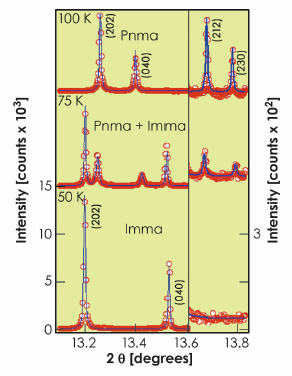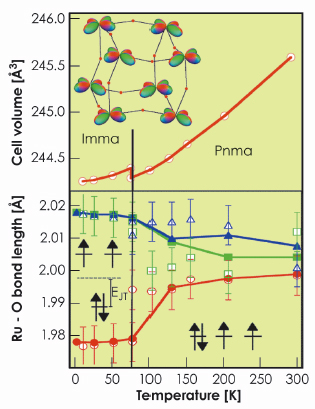- Home
- Users & Science
- Scientific Documentation
- ESRF Highlights
- ESRF Highlights 2009
- Structure of materials
- Symmetry-raising orbital order in PbRuO3
Symmetry-raising orbital order in PbRuO3
Transition metal oxides display a remarkable range of electronic and magnetic phenomena such as high temperature superconductivity in cuprates and colossal magnetoresistances in manganese oxides. Ruthenates based on Ru4+ are notable for being metallic conductors without chemical doping and show a variety of phenomena at low temperatures. The perovskite SrRuO3 becomes ferromagnetic on cooling below 160 K and is used in many thin film electronics applications. This material can be prepared at ambient pressure, whereas lead ruthenate, PbRuO3, requires high synthesis pressures and so its properties had not been investigated since it was originally reported, in 1970 [1]. Our investigation has revealed a very different low temperature state to that of SrRuO3, in which ordering of Ru 4d orbitals results in an anomalous structural change to higher symmetry at low temperatures.
Polycrystalline samples of PbRuO3 were synthesised by heating a pyrochlore-type precursor Pb2Ru2O6.5 at 11 GPa and 1100°C in a multi-anvil press. Magnetisation and conductivity measurements revealed a transition at 90 K but without magnetic order below this temperature. To determine any structural changes occurring at the transition, high resolution powder X-ray diffraction patterns between 10 and 300 K were collected at beamline ID31. The ambient temperature structure of PbRuO3 was found to be very similar to that of SrRuO3. Tilting of the RuO6 octahedra leads to a primitive orthorhombic superstructure of the perovskite structural arrangement that is described by the space group Pnma.
On cooling through the transition, a new set of diffraction peaks belonging to a different superstructure appear and coexist with the Pnma phase, showing that the transition is discontinuous (Figures 53 and 54). Surprisingly, the Pnma superstructure reflections with odd (h + k + l) values disappear, which indicates that the low temperature phase has a higher (body-centred) symmetry than the room temperature structure. The low temperature phase has a different tilted arrangement of octahedra with space group Imma.
 |
|
Fig. 53 : Part of the powder X-ray diffraction profiles of PbRuO3 at 50, 75 and 100 K ( |
The Ru-O bond distances derived from the refined crystal structure (Figure 54) reveal that orbital ordering occurs at the 90 K transition in PbRuO3. The RuO6 octahedra are almost regular in the Pnma phase, but below the transition, a Jahn-Teller distortion is apparent in the Imma structure, with two short and four long Ru-O bonds. This corresponds to a dxy2dxz1dyz1 orbital ordering of the Ru4+ t2g4 configuration in the Imma phase, creating planes of doubly-occupied dxy orbitals as shown in Figure 54. The Ru orbital order is coupled to an unusual distortion of the Pb2+ coordination which has a near-regular square pyramid with five short (2.50 Å) Pb-O bonds, while other Pb-O distances are greater than 2.82 Å, although no ‘lone pair’ distortion is evident.
The (high temperature) Pnma to (low temperature) Imma transition in PbRuO3 is remarkable as Pnma is a subgroup of Imma so a continuous transition from (high temperature) Imma to (low temperature) Pnma would normally be expected. Indeed, it has been observed in many simple perovskites such as SrSnO3 [2]. The symmetry-raising Pnma-Imma transition in PbRuO3 would have a negative structural contribution to the transition entropy, but this is evidently outweighed by the large positive electronic contribution from the loss of orbital order at the transition.
 |
|
Fig. 54: Temperature variations of the unit cell volume (top) and Ru-O bond distances (bottom, open symbols from ID31 X-ray structure refinements, filled symbols from complementary GEM@ISIS neutron structure refinements) for PbRuO3. The orbital ordering transition is marked by a volume discontinuity and by changes in the Ru-O distances. The RuO6 octahedra are almost regular in the high temperature Pnma structure, but in the Imma phase they are distorted with two short axial bonds (red points) and four long equatorial bonds (blue and green points). This signifies a Jahn-Teller distortion that lifts the degeneracy of the Ru4+ t2g-type d-orbitals as shown. The long range order of the doubly-occupied dxy orbitals is shown on the upper panel. |
In conclusion, a new, orbitally-ordered, low temperature electronic state for ruthenates has been discovered. The orbital distortion appears to be stabilised by coupling to electronic instabilities of the Pb2+ cations. The combined order of Pb s and p hybridised orbitals, Ru d-orbitals and O-centred octahedral tilting instabilities results in an anomalously high symmetry ground state structure that inverts the usual group-subgroup symmetry lowering.
References
[1] J.A. Kafalas and J.M. Longo, Mat. Res. Bull. 5, 193 (1970).
[2] E.H. Mountstevens, S.A.T. Redfern and J.P. Attfield, Phys. Rev. B 71, 220102(R) (2005).
Principal publication and authors
S.A.J. Kimber (a,b), J.A. Rodgers (b), H. Wu (c), C.A. Murray (b), D.N. Argyriou (a), A.N. Fitch (b), D.I. Khomskii (c,e) and J.P. Attfield (b), Phys. Rev. Lett. 102, 046409 (2009).
(a) Helmholtz-Zentrum Berlin für Materialien und Energie (Germany)
(b) Centre for Science at Extreme Conditions and School of Chemistry, University of Edinburgh (UK)
(c) II. Physikalisches Institut, Universität zu Köln (Germany)
(d) ESRF
(e) Department of Physics, Loughborough University (UK)



